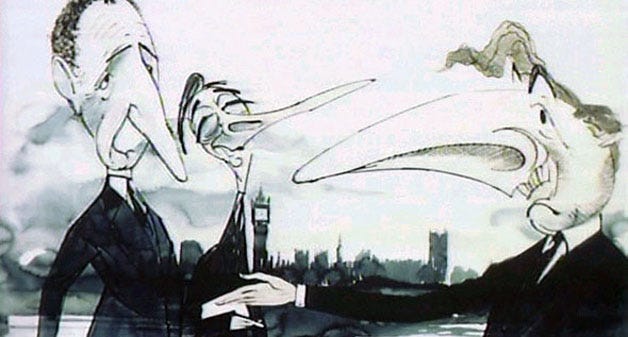The 6+6 Tool Cheat-Sheet of the IAS Policy-Makers
How IAS officers skillfully stir the pot of policy-making before and after it’s served to the public.
First published on Medium.com on Jan 16, 2019 captioned “12 Tools in the Cheat-Sheet of the IAS Policy-Makers”1. I have revised it comprehensively.
The Citadel under Siege: There is a peculiar hum in the hallowed halls of North Block, New Delhi, home to the Ministries of Finance, Home and Personnel. This hum is none other than our beloved IAS officers, who are squaring up against the relentless battering ram of specialists and super-specialists both inside and outside the Government. As the fort of "generalism" shows signs of a few loose bricks, our valiant IAS officers are picking up their shields of "policy-making" expertise2.
The IAS Association has turned into a sort of marketing department for this shield, selling it as the Swiss Army Knife of governance – a multi-, inter- and intra-disciplinary tool, good for any situation, thanks to their varied experience at sub-district, district, State, and National levels. Their frequent interactions with politicians and political executives have supposedly made them seasoned diplomats, well-versed in translating political complexities into pragmatic policies that everyone can swallow3.
But as our favourite cynic Sir Humphrey Appleby from the BBC Serial, “Yes, Prime Minister” once said, “Well, almost all Government policy is wrong, but… frightfully well carried out.”
Section 1: "The Art of the Sale: How IAS Officers Prep for Policy Rollout"
In the spirit of turning a blind eye to this not-so-hidden truth, IAS officers have a well-practiced routine they follow in the lead-up to a policy announcement:
The Discrediting Act: Trash the current state of affairs and point fingers at the existing policy.
Elixir Euphoria: Promote the upcoming policy as the silver bullet solution to all societal woes.
Simplicity Sell: Emphasize how wonderfully simple and cost-effective the new policy is, in contrast to its promised benefits.
Vague Victory: Keep positive outcomes hazy. Stick to qualitative buzzwords like “significant,” “optimal,” or our personal favorite, “reasonable.”
Consultation Charade: Hold ‘public consultations’ where the main agenda is to stick to the original draft. The consultations are a sleight of hand to eliminate any surprise attacks and silence potential protests.
Contingency Card: State that the policy's success is contingent upon the perfect alignment of variables like finance, budget, human resources, institutional support, and others.

Section 2: "Post-Policy Dance: The Survival Strategies of IAS Officers"
And when the policy rolls out and fails to do the cha-cha as expected, the officers pull out the second half of their toolkit:
Patience Plea: They argue it's too early to see the fruits of their labour and remind us of gestation periods, promising that a healthy baby (read policy) will soon be delivered.
Survey Shield: They commission a small sample survey, preferably conducted by reputable academicians, to back their claims.
PR Parade: They share anecdotal success stories but shy away from verifiable statistics. Instead, they deliver macro figures with the skill of a magician pulling a rabbit out of a hat.
Implementation Indictment: They deflect criticism by blaming poor implementation for letting down their excellent policy.
Counterfactual Conjecture: They admit things didn't improve significantly, but argue that without this policy, we would be in a worse-off scenario.
Objective Overreach: They highlight unintended benefits and positive outcomes not directly attributable to the new policy.
Policy is our Monopoly: So, there you have it - the magician never reveals his tricks, but we've got the IAS playbook out in the open. Whether it's to maintain their grip over policy-making or to dance in tune with highly paid consultants, the IAS officers have their strategy sorted. After all, who needs a formal burial for failed policies when they can quietly fade away without state honours?
12 Tools in the Cheat-Sheet of the IAS Policy-Makers
How the IAS Officers prepare sedulously before and after notifying a public policy IAS officers, confronted with an organized onslaught from a vocal lobby of specialists and super-specialists, both within and outside the Government, are closing their ranks to prot…
IAS Officers’ Secret Toolkit to Tackle Political Pressure
Serious or Frivolous, You Decide! Originally published by mein May 2021, this mysterious revelation took the bureaucratic world by storm, spreading like wildfire, not so much on the internet as in the super-exclusive WhatsApp groups of IAS officers. Now, after having its clandestine moment in the shadows, the time is ripe for it to step back into the lim…
"Politician vs. IAS": A 16-Point Cheat-sheet for the Politicians
Why did I decide to write this piece? As I divulged the simple yet powerful "IAS Officers’ Toolkit to Tackle Political Pressure," an unexpected request echoed from all across the political spectrum. Public representatives, regardless of their political affiliations, began to seek, nay demand, a similar road-map to help them traverse the intricate and of…





